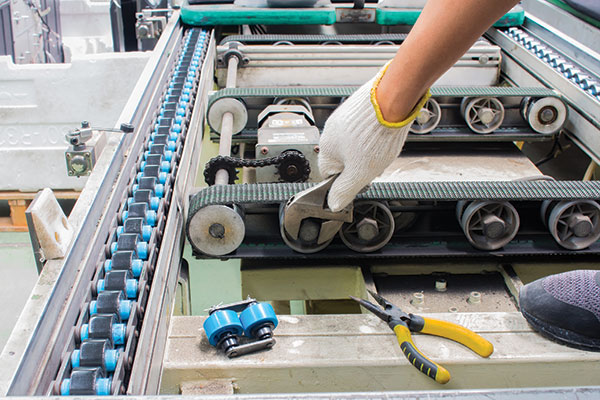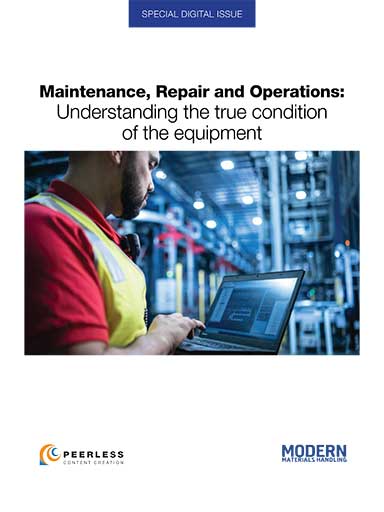Resetting your maintenance repair and operations (MRO) strategy
In this transcript of an ISM-sponsored Webcast, Andrew Kelley and Rob Fijalkowski discuss spare parts strategy during Covid and the future.
Managing spare parts is making a rapid departure from the days of clipboards and ready availability of all parts at all times. This ISM-sponsored Webcast addresses how MRO spare parts strategies are changing as you read this. Key areas include rethinking forecasts and increased visibility of parts across the supply chain. Also important is breaking down silos, eliminating spare parts secrets and looking for new options to collect and share information. Considering how spare parts have been traditionally managed, this talk borders on radical—but in a good way.
Guests on this Webcast are Andrew Kelley, a supply chain executive who at the time of the recording was with Boxlock, and Ron Fijalkowski, senior vice president of supply chain for SDI. The moderator is Bob Trebilcock, executive editor of Modern Materials Handling.
Bob Trebilcock: Today we’re talking about changes in spare parts strategy. Unfortunately, companies still struggle to get timely information about the status of parts.
When the two of you are talking to companies, what are the challenges they are facing today with spare parts? And are they different than the problems they were trying to solve before Covid? Let’s start with you, Andrew.
Andrew Kelley: I was just talking to a company that’s got many cages and hundreds of people with access. But they really need that to be just a handful of people.
Part of the issue is who has access control and knowing where the parts are. It’s a matter of the right people having access to the right parts at the right time. As to pre- versus post-Covid, this is a persistent challenge.
Trebilcock: Ron, I want to ask you the same basic question, but with a twist because at SDI you manage spare parts for companies and you supply spare parts. How are we migrating from having all the stock we’ve traditionally had on hand to dealing with shortages?
Ron Fijalkowski: Going back to the original question, I don’t think the problem has changed. The problem is still for scheduling and staging parts for technicians when the technicians need them. And that requires visibility for when the parts arrive.
Your point is well taken that since Covid there are shortages. Parts that used to arrive in 5 to 7 days are now arriving in 25 days.
Then there’s the matter of forecasting, which is based on historical use. But we’ve just come off a year of completely insane forecasting.
The bottom line is that what we’re seeing is that many of our customers are saying let’s look at what is critical inventory and start to carry it even though they never did before. They can’t continue to rely on just-in-time delivery.
Trebilcock: I’m going to stay with you, Ron, on this next question. When you think about spare parts management, how important is visibility? And how can we improve?
Fijalkowski: Visibility is critical. And I think that visibility is not just to show where demand is. Visibility is also about knowing where inventory is.
Identifying demand is where we’re doing a lot of work. We’re focusing on AI (artificial intelligence) tools and use them to better forecast demand. In the past, forecasting was based on very stable data over years. We don’t have that now. And the whole idea of using min/max for spare parts just has to go away.
The big challenge is to have a dynamic methodology that can adjust quickly and is attached to the asset. People are not afraid of owning reasonable inventory. They’re afraid of having to write off certain parts because they’ve eliminated assets, but still have those spare parts on hand.
People are starting to say they need to have work orders attached to an asset, the asset attached to a bill of materials, and the bill of materials attached to the parts. That creates a full chain. And now they want to adjust to it dynamically.
Trebilcock: Andrew, visibility is kind of what you do along with security. So, from your perspective, talk a little about the importance of visibility.
Kelley: It’s kind of like real estate: Location. Location. Location. In terms of your parts, if you don’t know where things are, there’s a problem. And even beyond just spare parts this goes across the supply chain to have a scheme for tracking and cataloging things. Bar codes work here.
Then, you can start aggregating. And as volumes grow, you can go to lot sizes. But whether it’s a part or a lot, knowing where it is in your supply chain is beneficial all the way to the balance sheet.
Trebilcock: I want to talk about best practices for spare parts strategies. And I want to ask you, Ron, to comment on best practices like forecasting going forward.
Fijalkowski: I’m seeing most forecasting struggling with the patterns in 2020 and 2021. Now it requires some human input to say if the business is back to what it was or is somehow different.
The best practice I foresee is incorporating all of the suppliers into an ecosystem where all parts are in one catalog. You don’t want your people going through hundreds of sites to find parts. That’s not a best practice, but historically has been how it worked.
Trebilcock: Andrew, what’s your take on this?
Kelley: Getting parts closer to the point of consumption is a best practice. The idea is to cut the time needed to get the part to who needs it.
Trebilcock: Have there been any adjustments to MRO repairs since so many people are working from home, Ron?
Fijalkowski: With fewer people in buildings, maintenance can go in and make repairs without having to confine them to nights and weekends, for instance.
But overall, have I not seen instances of technicians with no work to do. Absolutely not.
Trebilcock: But, Ron, have you seen where a lack of technicians has had an impact on making MRO repairs?
Fijalkowski: Absolutely, there’s a shortage of people. We’ve seen our customers trying to make those people who are available much more efficient. Some of this is simplifying how technicians place orders. If delivery isn’t on time, then that’s another hold up. The idea is to cut out the waste here and optimize technicians’ time to make repairs.
Trebilcock: How has MRO changed with Covid?
Kelley: The ability to hold parts for delivery and contactless delivery are important going forward. Eliminate the need for person-to-person transfer. Being able to access parts when the maintenance team is working is really important, too.
Trebilcock: What developments are on the horizon to offer visibility into the entire service parts supply chain?
Kelley: This is a really broad-reaching question. Let’s just focus on the MRO industrial space.
The No. 1 thing is data across operations, across enterprises, across supply chains. We’ve long focused on best-in-breed, which means we have really good tools in each segment of the supply chain. But it’s not so easy to move data across not just departments, but across enterprises and the supply chain.
The No. 1 thing is having a big picture view of the data. That requires high-level involvement from supply chain senior vice presidents to top people at vendors. How can they get data flowing across the different buckets?
Trebilcock: Ron, same question. What advancements are on the horizon to extend visibility across the whole process?
Fijalkowski: Andrew mentioned eliminating silos. The typical process is technicians assess a problem, planners order parts, parts arrive and get distributed and finally used. But there are always gaps in information about exactly what happened in that process.
What we’re working on is let’s put all of that into a connected dashboard that links the ordering process back to the work order and then links back to the asset. Tying all the silos together allows everyone involved to pull the data and slice it. That’s a critical connection.
I think the technology is there to do this. But it hasn’t been applied to the spare parts process.
Trebilcock: One technology that seems to fit here, but never seems to get anywhere, is blockchain. It seems like MRO and repairs is a logical space for blockchain. Do either of you think that might come next?
Kelley: Having an immutable record is important. But most of the people we talk to don’t have any records. They’re using clipboards and notebooks.
Blockchain would be a great leap forward. There are plenty of existing technologies companies can use today rather than blockchain to go from no records to some records. That is the biggest help for a lot of people we talk to. And then for those who do keep records, move to immutable records.
Fijalkowski: I’m a big fan of blockchain. We’ve looked at it. I think once blockchain gets in place, which will be awhile, it has a great opportunity to simplify the waste between ordering and fulfillment of orders.
Trebilcock: Let’s talk about a leap forward with digital records. Andrew, please talk about digital records and where they’re going.
Kelley: At BoxLock, we use either bar codes or QR codes to digitize the supply chain. It’s a long way from collecting data on clipboards.
Step one is having enough of the enabling tools to get the data. Step two is turning that data into information. And step three is turning that information into action.
Trebilcock: So, Ron, at SDI you create records for your own use. But how do advise clients start their own records and use them?
Fijalkowski: First of all, try to eliminate the disconnect between your various systems. Start with the work order and follow all the way through the steps to getting the repair made. Data can’t be a secret.
Trebilcock: What role might robotic process automation (or RPA) play into optimizing procurement or the time spent on MRO, Ron?
Fijalkowski: Using RPAs eliminates the need for the people who have been part of the process. And build it right into the system. Avoid the system integrations.
Trebilcock: Andrew, in talking to your customers are you seeing RPA coming into play?
Kelley: We’re already using RPA at BoxLock. Think of it as an if/then scenario. Our customers want to use it to reconfigure reports dynamically. Use it to make decisions on groups or time of day that are recurring.
Trebilcock: Thank you both for being a part of this. And thanks to ISM for sponsoring this Webcast.














